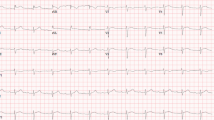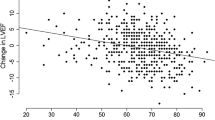Abstract
Background
Stress lung thallium 201 uptake correlates with left ventricular (LV) dysfunction and extent of coronary artery disease (CAD). Although Tl-201 is used less commonly for stress imaging, dual-isotope stress and viability protocols continue to use Tl-201 for rest imaging. We sought to investigate the association between increased resting Tl-201 lung-to-heart ratio (LHR) and hemodynamic indices of LV dysfunction, indices of myocardial perfusion, and extent of CAD.
Methods and Results
Over a 1-year period, we identified 192 consecutive patients who underwent dual-isotope stress perfusion imaging and cardiac catheterization within 30 days, without interim events or revascularization. Resting LHR was measured, and its association with invasively measured hemodynamic parameters, extent of CAD, and indices of myocardial perfusion at rest and stress was examined. Increased resting Tl-201 LHR was weakly but significantly associated with lower LV ejection fraction (EF) (r = 0.209, P < .05), higher pulmonary capillary wedge pressure (r = 0.25, P < .005), and LV end-diastolic pressure (r = 0.215, P < .01) but not with pulmonary artery systolic pressure. Increased LHR was also weakly associated with rest perfusion abnormalities including the sum rest score (r = 0.271, P < .001) and number of abnormally perfused segments (r = 0.25, P < .001) bud did not correlate with stress perfusion indices or ischemic burden. The 76 patients (40%) with LHR greater than 0.5 were more likely to have LVEF lower than 40% and 3-vessel/left main CAD.
Conclusions
Increased rest Tl-201 LHR is weakly associated with higher LV end-diastolic pressure and pulmonary capillary wedge pressure and lower LVEF. LHR is also associated with the extent of previously infarcted myocardium and may indicate the presence of 3-vessel/left main CAD. (J Nucl Cardiol 2003;10:140-7.)
Similar content being viewed by others
References
Boucher CA, Zir LM, Beller GA, et al. Increased lung uptake of thallium-201 during exercise myocardial imaging: clinical, hemodynamic and angiographic implications in patients with coronary artery disease. Am J Cardiol 1980;46:189–96.
Kushner FG, Okada RD, Kirshenbaum HD, et al. Lung thallium- 201 uptake after stress testing in patients with coronary artery disease. Circulation 1981;63:341–7.
Liu P, Kiess M, Okada RD, et al. Increased thallium lung uptake after exercise in isolated left anterior descending coronary artery disease. Am J Cardiol 1985;55:1469–73.
Homma S, Kaul S, Boucher CA. Correlates of lung/heart ratio of thallium-201 in coronary artery disease. J Nucl Med 1987;28:1531–55.
Morel O, Pezard P, Furber A, et al. Thallium-201 right lung/heart ratio during exercise in patients with coronary artery disease: relation to thallium-201 myocardial single-photon emission tomography, rest and exercise left ventricular function and coronary angiography. Eur J Nucl Med 1999;26:640–6.
Hansen CL, Sangrigoli R, Nkadi E, Kramer M. Comparison of pulmonary uptake with transient cavity dilation after exercise thallium-201 perfusion imaging. J Am Coll Cardiol 1999;33:1323–77.
Hansen CL, Cen P, Sanchez B, Robinson R. Comparison of pulmonary uptake with transient cavity dilation after dipyridamole Tl-201 perfusion imaging. J Nucl Cardiol 2002;9:47–51.
Gibson RS, Watson DD, Carabello BA, Holt ND, Beller GA. Clinical implications of increased lung uptake of thallium-201 during exercise scintigraphy 2 weeks after myocardial infarction. Am J Cardiol 1982;49:1586–93.
Mannting F. Pulmonary thallium uptake: correlation with systolic and diastolic left ventricular function at rest and during exercise. Am Heart J 1990;119:1137–46.
Chin BB, Moshin J, Bouchard M, et al. Hemodynamic indices of myocardial dysfunction correlate with dipyridamole thallium-201 SPECT. J Nucl Med 1996;37:723–9.
Brown KA, McKay R, Heller GV, et al. Hemodynamic determinants of thallium-201 lung uptake in patients during atrial pacing stress. Am Heart J 1986;111:103–7.
Kaul S, Finkelstein DM, Homma S, et al. Superiority of quantitative exercise thallium-201 variables in determining long-term prognosis in ambulatory patients with chest pain: a comparison with cardiac catheterization. J Am Coll Cardiol 1988;12:25–34.
Jain D, Lahiri A, Raftery EB. Clinical and prognostic significance of lung thallium uptake on rest imaging in acute myocardial infarction. Am J Cardiol 1990;65:154–9.
Travin MI, Boucher CA, Newell JB, et al. Variables associated with a poor prognosis in patients with an ischemic thallium-201 exercise test. Am Heart J 1993;125:335–44.
Iskandrian AS, Chae SC, Heo J, et al. Independent and incremental prognostic value of exercise single-photon emission computed tomographic (SPECT) thallium imaging in coronary artery disease. J Am Coll Cardiol 1993;22:665–70.
Ho KT, Miller TD, Christian TF, Hodge DO, Gibbons RJ. Prediction of severe coronary artery disease and long-term outcome in patients undergoing vasodilator SPECT. J Nucl Cardiol 2001;8:438–44.
Palmas W, Bingham S, Diamond GA, et al. Incremental prognostic value of exercise thallium-201 myocardial single-photon emission computed tomography late after coronary artery bypass surgery. J Am Coll Cardiol 1995;25:403–9.
Berman DS, Kiat H, Friedman JD, et al. Separate acquisition rest thallium-201/stress technetium-99m sestamibi dual-isotope myocardial perfusion single-photon emission computed tomography: a clinical validation study. J Am Coll Cardiol 1993;22:1455–64.
Tamaki N, Itoh H, Ishii Y, et al. Hemodynamic significance of increased lung uptake of thallium-201. AJR Am J Roentgenol 1982;138:223–8.
Marcassa C, Galli M, Baroffio C, et al. Independent and incremental prognostic value of (201)Tl lung uptake at rest in patients with severe postischemic left ventricular dysfunction. Circulation 2000; 102:1795–801.
NIH Image. Research Services Branch Web site. Available at http://rsb.info.nih.gov/nih-image/.
Aepfelbacher FC, Johnson RB, Schwartz JG, et al. Validation of a model of left ventricular segmentation for interpretation of SPET myocardial perfusion images. Eur J Nucl Med 2001;28:1624–9.
Kaul S, Chesler DA, Boucher CA, Okada RD. Quantitative aspects of myocardial perfusion imaging. Semin Nucl Med 1987;17:131- 44.
Choy JB, Leslie WD. Clinical correlates of Tc-99m sestamibi lung uptake. J Nucl Cardiol 2001;8:639–44.
Hurwitz GA, Ghali SK, Husni M, et al. Pulmonary uptake of technetium-99m-sestamibi induced by dipyridamole-based stress or exercise. J Nucl Med 1998;39:339–45.
Bacher-Stier C, Sharir T, Kavanagh PB, et al. Postexercise lung uptake of 99mTc-sestamibi determined by a new automatic technique: validation and application in detection of severe and extensive coronary artery disease and reduced left ventricular function. J Nucl Med 2000;41:1190–7.
Romanens M, Gradel C, Saner H, Pfisterer M. Comparison of 99mTc-sestamibi lung/heart ratio, transient ischaemic dilation and perfusion defect size for the identification of severe and extensive coronary artery disease. Eur J Nucl Med 2001;28:907–10.
Saha M, Farrand TF, Brown KA. Lung uptake of technetium 99m sestamibi: relation to clinical, exercise, hemodynamic, and left ventricular function variables. J Nucl Cardiol 1994;1:52–6.
Martinez EE, Horowitz SF, Castello HJ, et al. Lung and myocardial thallium-201 kinetics in resting patients with congestive heart failure: correlation with pulmonary capillary wedge pressure. Am Heart J 1992;123:427–32.
Atkins HL, Budinger TF, Lebowitz E, et al. Thallium-201 for medical use. Part 3: Human distribution and physical imaging properties. J Nucl Med 1977;18:133–40.
Narahara KA, Hamilton GW, Williams DL, Gould KL. Myocardial imaging with thallium-201: an experimental model for analysis of the true myocardial and background image components. J Nucl Med 1977;18:781–6.
Bingham JB, McKusick KA, Strauss HW, Boucher CA, Pohost GM. Influence of coronary artery disease on pulmonary uptake of thallium-201. Am J Cardiol 1980;46:821–6.
Villanueva FS, Kaul S, Smith WH, et al. Prevalence and correlates of increased lung/heart ratio of thallium-201 during dipyridamole stress imaging for suspected coronary artery disease. Am J Cardiol 1990;66:1324–8.
Kahn JK, Carry MM, McGhie I, et al. Quantitation of postexercise lung thallium-201 uptake during single photon emission computed tomography. J Nucl Med 1989;30:288–94.
Author information
Authors and Affiliations
Corresponding author
Rights and permissions
About this article
Cite this article
Sanders, G.P., Pinto, D.S., Parker, J.A. et al. Increased resting Tl-201 lung-to-heart ratio is associated with invasively determined measures of left ventricular dysfunction, extent of coronary artery disease, and resting myocardial perfusion abnormalities. J Nucl Cardiol 10, 140–147 (2003). https://doi.org/10.1067/mnc.2003.399
Received:
Accepted:
Issue Date:
DOI: https://doi.org/10.1067/mnc.2003.399




